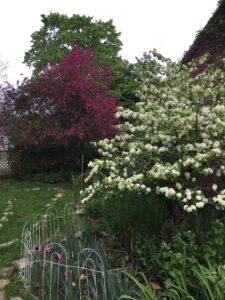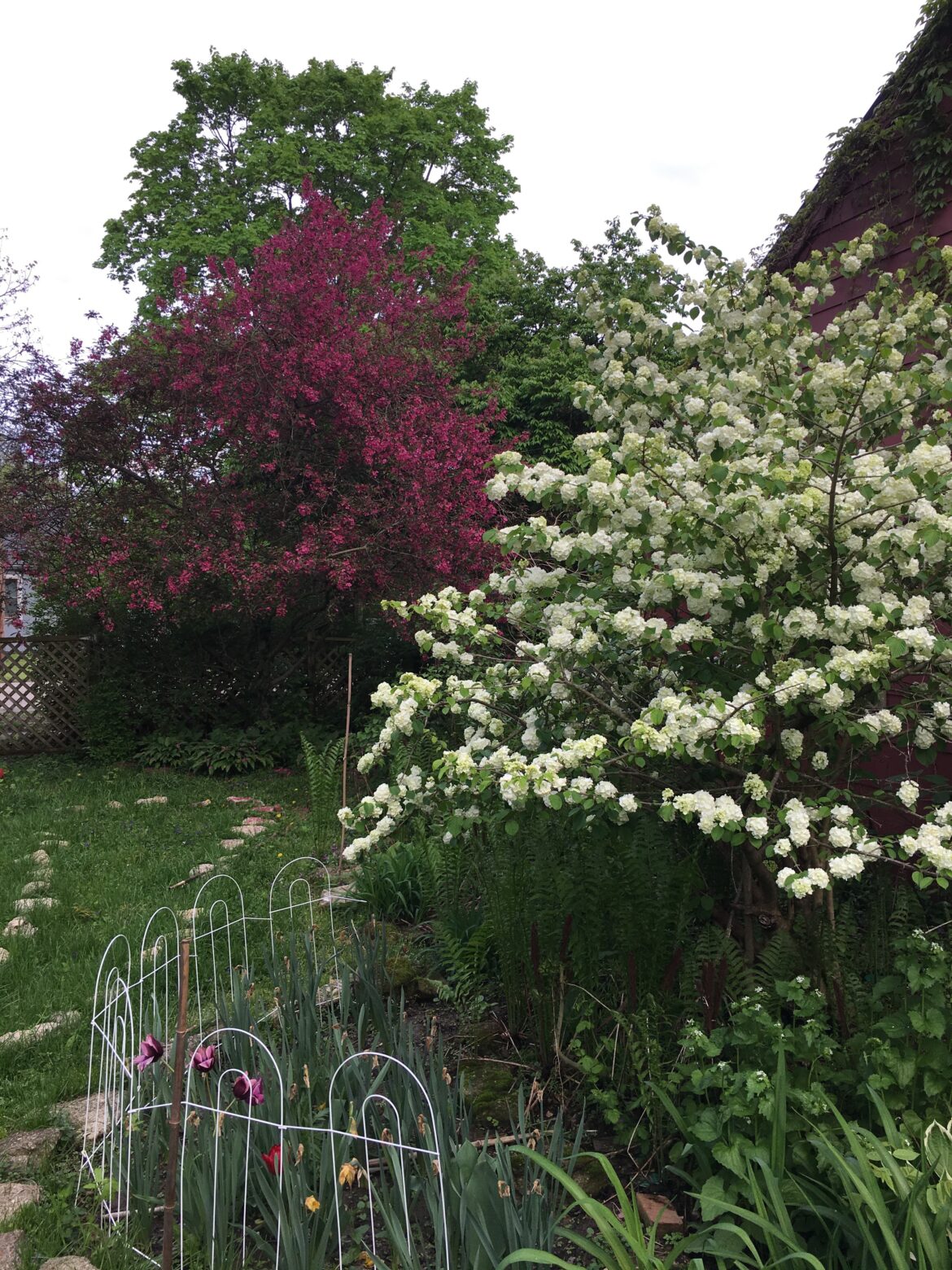April 30th
The 120th Day of the Year
And so vast is Spring you can’t set it down,
Say burgeoning bluebells, and besides
It’s coming up as the rain falls.
Plants riding the rising thermal gradient
Like Hawaiian surfers wearing flowered
Bathing suits and the spray from the
Breaking wave is cherry blossom spume
Blown from dark craggy trunks.
Robert Paschell
 Sunrise/set: 5:37/7:28
Sunrise/set: 5:37/7:28
Day’s Length: 13 hours 51 minutes
Average High/Low: 67/46
Average Temperature: 56
Record High: 90 – 1899
Record Low: 30 – 1892
Weather
Today’s high temperature distribution: 15 percent chance of 80s, forty percent of 70s, thirty-five percent of 60s, five percent of 50s, five percent of 40s. Chances of rain are 50 percent, but the clouds give way to sun 70 percent of the days. Today’s record high of 90 degrees from 1899 is the first record so warm in the year, and the first high above 90 since October 5th.
Natural Calendar
Many pines have new growth, some trees having pushed out tiny cones, others with fresh green needles at the tips of their branches. In town, many decorative pears have exchanged their flowers for leaves, and the forsythia shows almost no gold at all. Some orchard grass and rye are ready to harvest. Bluegrass can be budding
The Stars
The stars at bedtime tell that the danger of frost is almost past. June’s Arcturus still hangs a little to the east of the center of the sky, and that means a light freeze can happen one year in ten. But as that star shifts into the west, it pushes away the chances of freezing mornings with it. When Arcturus is well into the west at bedtime, any tender vegetable or flower can be planted without risk.
Daybook
1983: Field mustard (winter cress) blooming now. Pears leafing downtown; only a few crab apples keep their blossoms. Buckeye leaves fully developed.
1984: Leaves starting on my gingko and white mulberry.
1986: First wood sorrel seen today. First blooms on the lily-of-the-valley, sycamore leaves emerging.
1988: Cherry petals falling in the breeze. Daisies budded, half an inch across. Redbuds still in full bloom, apples and crabs too. Half the maples are leafing. Front maples just flowered, Lil’s a fourth size. Peak of bleeding heart bloom and foliage. Full green tint to the woods; oaks have begun.
1990: Redbud is leafing now. Fields of dandelions go to seed throughout the county. Cowslip gone about five days ago. Dove building a nest by my window, blue jay building in the apple tree. Dayflower foliage came up a couple of days ago. Buckeyes still in full bloom. Some maples completely leafed out, others just starting. Grape vines leafing. Purple deadnettle yellowing in the yard around the aging dandelions.
1991: First purple sweet rockets opened today. Some sycamore leaves are half size now. Lily-of-the-valley just starting to bloom along Dayton Street and in the pussy willow garden.
1993: In this cool spring, most apples, dogwoods, and cherries remain in full bloom. Pears are leafing, even though many still have flowers. The tree line into the North Glen valley is completely alive now either with new pale leaves or orange buds or golden flowers.
1995: Lilies-of-the-valley budded, and are almost open. There are buds too on the hawthorn trees. The first white lilacs found today. Petal fall begins in the back yard, and on scattered crab apple trees about town. The first level of the canopy, box elders and maples, pussy willows, honeysuckle, apples starts to close in. The center of dandelion bloom has passed – great fields of seeds now.
1996: Cowslip declining today across from the Covered Bridge.
1998: Oak leaves are two to three inches long by the Antioch sculpture studio, quite a bit larger than the “squirrel’s ear” size I said in the newspaper. Sycamores are two inches. Juniper has one to two inches of bright, pale green new growth.
2000: Very first flax and sweet William today. Thyme has been blooming in the garden for maybe two or three days. The first horseradish flowered yesterday or the day before. Poplar almost fully leafed, the front maple leaves half size, providing shade. Clematis fully budded. Ferns up two feet in places, the big blue hosta almost that high. The blue and white wood hyacinths in the south garden are in early bloom, and the small red dwarf tulips have come in over the past week.
2001: First spider web seen across the pond, woven by a small long-bodied orb weaver. Wood sorrel suddenly opens in the berry patch, bright yellow in the white strawberry blossoms. The pink azalea opens in the east garden. First sweet rocket seen along Grinnell Road.
2002: Very first Korean lilac flower by my office in Columbus.
2003: Wood hyacinths are just starting to open by the west wall, purples and whites. Along the freeways, the dandelion bloom has come to an end. Viburnums are in full bloom, redbuds and crabs losing their color, petals falling. First star of Bethlehem opened yesterday in the north garden. Two new redbud trees planted.
2006: Apple blossoms gone on many trees, but many still full bloom. Redbuds and the new apple in the east garden hold well.
2007: Robins, cardinals, sparrows, finches and grackles feeding and doves mating in the back yard this morning. Blue jays calling toward Dayton Street.
2008: White boneset is bushy now, about six inches tall. Three coleus planted in the east garden. The evenings so much quieter now. Redbuds and apples still full. Chives and allium have been budded for at least a week. Clematis, trumpet vine, wisteria leafing. White bleeding hearts have been open along the east fence for a few days.
2010: Dogwoods still full, but apples and redbuds are gone. Iris are coming in now, along with allium and honeysuckles. Grackles less frequent at the feeders, red-bellied woodpeckers more insistent.
2011: First star of Bethlehem opened today. Red-bellied woodpecker steady in the morning. Blue jays very active, feeding. Small toads hopping in the lawn and south garden. Indian and wood hyacinths showing violet on their buds, pink quince early opening, buckeyes starting to flower. The first yellow swallowtail of the year passed through the yard this afternoon, another seen as I drove back from the store.
2012: Black swallowtail and a zebra swallowtail seen at lunch. Yellow warbler in the faded lilacs at 1:40 this afternoon, and the first monarch butterfly as I worked in the north garden planting roses. Hyacinths, sweet Cicely, lamium, sweet rockets, honeysuckle, lily-of-the-valley, garlic mustard, perennial salvia, early spiderwort, dominate the yard. The dooryard azalea continues to hold on so bright pink, and the Korean lilac is still full.
2013: Ellis Pond: Hemlock past knee high. Toads in the distance. Norwegian maple with two-inch leaves, Maackia tree just starting to leaf. Redbuds and pink magnolia hold full. pawpaw with droplet-like leaf clusters. Sycamore leaves one to two inches. Half-inch cones starting on the spruce. At home, most of the daffodils and tulips are gone, will need to plant many more clusters for next Late Spring. The red crab apple is coming in strong, all the perennial foliage taking over throughout the gardens. Paulownia and tree of heaven are finally starting to leaf.
2014: Ellis Pond: American chestnut, pecan and European beech with straining buds, wild plum full late bloom, bur oak leaves, ginkgo and black cherry at about an inch, pear almost completely leafed, full late pink magnolia, Persian Parrotia with three-inch leaves, no life on the pawpaw, lacebark elm barely leafing, mountain ash and yellow buckeye with flower buds and leaf clusters. Toads in the distance. At home, the red crab apple is in full bloom, the daffodils and tulips almost gone. The azalea has two flowers, the rest of the bush hurt very severely by the cold winter.
2015: Planted tall kale, a few more pumpkins; transplanted three Lenten rose plants to the front garden, cut back more bamboo. In the front yard, our red crab apple is in early bloom and the very first wild geranium. The first lily-of-the-valley is just opening. Jogging through the village, I saw forget-me-nots full, wild cherry trees and crab apple trees full, a birch with dangling catkins, tree-of-heaven with short bristles of leaves, Paulownia buds barely showing, red quince holding, sweet gums just barely leafing, a few sizeable patches of tulips (and Moya’s vintage yellow tulips full bloom), aging but strong redbuds and snowball viburnums everywhere.
2016: Cold and rain: First catchweed found blooming, forget-me-nots late, behind the store downtown. The red crabapple in front of our house has dropped all its petals, wild geraniums full, ranunculus coming in the southeast garden.
2018: Frost this morning, hopefully the final frost of the year. The buds of Rachel’s ginkgo are finally opening a little, Jeanie’s river birch has pale yellow-green catkins and the box elder tree by my studio has luxurious dangling flowers. The final data on this April’s temperatures: the average was 45.9. That was 5.8 degrees below normal, the coldest since my personal records started in 1979. From my weather records from the airport files, Aprils colder than this year’s occurred in 1961 (45.6), 1950 (45.0), 1943 (45.7), 1926 (45.6), 1907 (42.8) and 1904 (45.4). Rainfall officially was 4.78 inches, but locally it must have been much more.
2019: Leslie reports seeing the first catbird. In my dooryard garden, the wild geraniums have started to open. At the north edge of the yard, the red quince is losing petals, pink quince full bloom.
2020: In the chilling rain, redbud flowers falling. At the pond, the red-flowering buckeye is fully budded, waiting for a day in the 70s. On the north side of the house, the North Carolina viburnum is dense with white overnight flowers. This afternoon at Ellis Pond, a flock of swallows skimmed the surface of the water back and forth and around in search of fresh hatch. In the spring water area, water cress was flowering. Todays unusual chilly conditions brought the month’s average temperature down a little more, to 50.1 degrees, a degree below average. Rainfall was 3.03 inches, about an inch low.
Journal: Waiting
Waiting for spring can be like trying to go to sleep when I have insomnia. Sometimes the best thing to do is to count. Counting is a simple measure of time, limits passage to individual pieces, takes away its mystery and emptiness. Counting is an act of will, forces focus, contributes to a sense of control, works against discouragement, places the counter in opposition to the psychology and physiology of sleeplessness.
Numbers are infinite, and so are the pieces of winter. Nevertheless, counting in sequence creates apparent progress and finite limits. Even though awareness of winter’s events seems to produce few results, seems to have no sum or substance, observations can be like digits in a sprawling but promising nighttime equation, the fruit of persistence and dogged hope.
Like counting sheep or breaths or numerals, counting dimensions of the interval between autumn and May requires no rules or ethics, is not competitive, does not require special study or skill. Like counting sheep or breaths or numerals, the choice of things to be counted is arbitrary, has no necessary socially redeeming value, does not end poverty or bring peace, has no theology.
This is the anarchy, the freedom that loosens the mind’s eye to rhythm or accumulation or listing or repetition or the emptiness of any single object until something new suddenly occurs without our creating it and we fall asleep and dream or discover spring.


